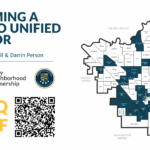You have probably heard the short catchphrase, “Bloom where you are planted!” The phrase is meant to encourage us to dig deep into the areas where we live, work and play. But have we ever stopped to question the premise? Have we ever asked ourselves, “Where should I plant myself?”
Where we live matters. Where we live is often a reflection of our values. For those in the middle to upper class bracket (where I put myself) we typically make the decision where to live based on safety, comfort and the best opportunities. Another way to say those values is to say the American Dream. The American Dream is the pursuit of individual opportunity, prosperity and success that includes upward social mobility.[1] The American Dream tells us the good life is one of our own personal comfort and safety.
So as people who are trying to live on mission with God and want to bloom where we are planted, I encourage you to consider Jesus’ example of moving into the world, what has happened in Fresno as we have lived the American Dream and consider a new way.
I believe God may want to uproot some of us so we can bloom in other neighborhoods. I believe this is vital to the mission of God in our city and our own flourishing.
I believe when most of us choose jobs, churches, homes and schools we use the American Dream as the filter and then justify it by using the phrase, “Bloom where you are planted.” We move toward comfort and safety, and spiritualize it after the fact. Let’s consider how Jesus chose to move into our world:
And the Word became flesh and dwelt among us, and we have seen his glory, glory as of the only Son from the Father, full of grace and truth. – John 1:14 (ESV)
Where did Jesus plant Himself? Jesus gave up the most safe and comfortable place: heaven! He planted Himself in the midst of a broken humanity. As He moved to earth He didn’t choose to incarnate in Herod’s palace, but was born into a poor family in a tiny village. He was the illegitimate child of a teenage mom, and was raised by a man who was not His biological father. He was an illegal immigrant who fled from the Middle East to North Africa to escape genocide. Upon His return He was a blue-collar worker. As He began His ministry He never had a home, but moved from city to city with enough funds to make it through the day and take care of the people around Him. At the end of His life He was arrested on false charges, beaten by the police and ultimately executed falsely with a racial slur over His head.[2]
We can clearly see Jesus rejected the American Dream. What has been the result of the American Dream in Fresno?
Fresno experienced what most American cities experienced, but what has been dubbed “white flight,” where people of means and resources have made exoduses from the city. They moved north and created new cities (i.e. Clovis) outside of the urban core. In a desire for the American Dream the city expanded. The map below[3] shows the pre-1946 growth in Fresno (shades of blue) and the post-1945 growth in Fresno (shades of red). Obviously there has been a lot of expansion outward.
Now look at the other maps below. These maps display the elementary school ratings (from 1-10) and the neighborhoods that have high concentrations of poverty.[4] (The current poverty line for a family of four is $24,250.)[5]
Also look below at the Racial Dot Map[6] of the Fresno area (White – blue dots, Hispanic – orange dots, Asian – red dots, Black – green dots, Other/Native American/Multi-racial – brown dots).
Do you see any similarities?
As educated, middle/upper class, white families left for the newest homes, best neighborhoods and top schools, they left behind the less educated, poorer, minority families who couldn’t leave for new homes in nice neighborhoods. This concentrated the poor and less educated to the urban center and left the inner city in dire conditions. In a desire for the American Dream we created an American Nightmare in our city. We chose Herod’s palace instead of Jesus’ incarnation.
These maps illustrate the fact that where we live matters. If the people of means in our city were allocated in every neighborhood, our city would look dramatically different. Instead, we think in individualistic terms and say it is not our problem.
But it is our problem.
Imagine if Jesus and the Holy Spirit were chatting and said, “Let’s bloom where we are planted!” But the gospel is that Jesus didn’t sit in heaven and say, “Well, not my problem.” He made our mess His problem.
He came to this earth and lived among us. He came to show us what love is like, to offer us new life today and forevermore. Jesus started His ministry proclaiming that radical change would be the sign of His ministry. People would have sight, poor would be given opportunity, people would be set free. Lives would change and our city would change. People would know who the Son of God is, and that would change their current worldview and their eternal destination.
When we don’t consider our motives for choosing our jobs, churches, homes and schools, we do not allow the gospel, God’s mission and the example of Jesus to influence the process.
The very nature of the gospel is that God became man and incarnated. Jesus was all about rejecting the safety, comfort and “the best” heaven had in order to show us His love and give us a way to accept that love.
As the church continues to figure out how to be missional, there is a growing movement of people in our city and across the world who are incarnating the gospel in new and fresh ways. There is a growing movement of people who are asking the Lord, “Where should I be planted?” These people are challenging the American Dream and considering how they can model our Lord, who didn’t pursue upward mobility but downward mobility. This is not an easy call, and these words are not meant to guilt but to challenge.
Jesus stands opposed to the American Dream. May we continue to allow the gospel, the mission of God and the example of Jesus to influence our decisions.
To learn more about incarnating into urban neighborhoods, I recommend starting withMaking Neighborhoods Whole by Wayne Gordon and John M. Perkins.
[2] “The Incarnation – I Didn’t Know Jesus Was Like That” by Feisty Thoughts
[3] Local Setting Map in the City of Fresno Map Atlas – Existing Conditions Report created by the City of Fresno. Public Record. Source: Boundary and circulation information, City of Fresno Development And Resource Management Department, 2010; World Street Map, developed by Esri using DeLorme basemap layers, Automotive Navigation Data, USGS, UNEP-WCMC, Tele Atlas Dynamap, 2009, City Boundaries, CA Department of Transportation, 2008. The City of Fresno has supplied the map. Any conclusions based on the map were drawn by the author.
[4] School Ratings 2015 Map and Fresno Poverty 2016 Map created by Every Neighborhood Partnership. Used with permission.
[5] U.S. Department of Health and Human Services 2015 Poverty Guidelines
[6] Racial Dot Map Image Copyright, 2013, Weldon Cooper Center for Public Service, Rector and Visitors of the University of Virginia (Dustin A. Cable, creator). Used with permission.











1 comment
Join the conversationGail Fast - September 21, 2016
Well written article Andrew. You are living in the poorest of neighborhoods and living as Jesus did. Continue to be a light in the darkness of poverty. Your proud mother-in-law